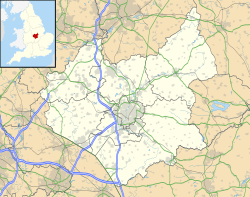Langley Priory facts for kids
| Monastery information | |
|---|---|
| Other names | Langley Nunnery |
| Order | Benedictine |
| Established | c.1150 |
| Disestablished | 1536 |
| Mother house | Farewell Priory |
| Dedicated to | "God and to the Blessed Virgin" |
| Diocese | Diocese of Lincoln |
| People | |
| Founder(s) | William and Burgia Pantulf |
| Site | |
| Location | Leicestershire, England |
| Coordinates | 52°48′28″N 1°21′30″W / 52.807776°N 1.358197°W |
Langley Priory was a special kind of religious building called a Benedictine nunnery in Leicestershire, England. It was a place where nuns, who were women dedicated to a religious life, lived and prayed together. You can find its remains about a mile and a half south of East Midlands Airport, near the village of Diseworth.
The Priory's Story
Langley Priory was started around the year 1150. It was founded by a couple named William Pantulf and his wife Burgia. The very first nuns who came to live at Langley came from another priory called Farewell Priory in Staffordshire.
William and Burgia gave the priory many gifts. William gave them the right to choose priests for churches in Little Dalby and Somerby. This right was called an advowson. He also gave them land in Langley, Little Dalby, Somerby, and Tonge. Burgia gave them land in Kettleby and a share of crops, known as tithes, from Tonge and Wilson.
Before the year 1205, the priory had gained even more land. They owned land in places like Burrough, Diseworth, and Nottingham. They also gained the advowson for Diseworth Church before 1220. By 1291, the priory was earning about £20 each year from its lands and properties.
The priory belonged to the Benedictine Order, which is a specific group of monks and nuns. However, in the late 1200s, the nuns tried to say they belonged to the Cistercian Order. They did this because Cistercian monasteries didn't have to pay tithes on their land. But they were eventually told they couldn't do this and had to pay up.
In 1354, a bishop named John Gynwell, Bishop of Lincoln, visited the priory. He wrote down that there were 12 nuns living there. Later, in 1440, another bishop, William Alnwick, Bishop of Lincoln, visited. He found that the number of nuns had dropped to eight. The priory's income had also fallen, and they were £50 in debt.
In 1535, a survey called the Valor Ecclesiasticus showed the priory's income was about £29 per year. By June 1536, only six nuns and the prioress (the head nun) were living there. The priory was likely closed down in 1536. This was part of a big event in England called the Dissolution of the monasteries, when many religious houses were closed by the king.
What Happened Next
After the priory was closed, its buildings were thought to have been used to build a new house. This house was also called "Langley Priory."
Today, not much of the original medieval priory building remains. The main part of the current house was completely rebuilt in the early 1800s. The two side sections were mostly rebuilt in the 1500s and 1600s.
The house is now used as a place for weddings. Even though it's in Leicestershire, its website sometimes says it's in Derbyshire!


